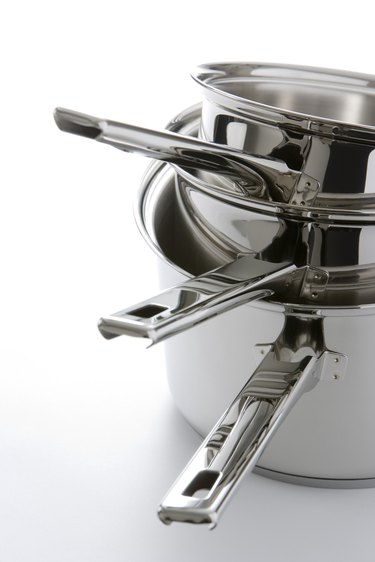
The acidity in tomato products such as tomato juice react with copper, iron and aluminum pots and containers, leeching out metals and making food taste metallic. Stainless steel is nonreactive, staying chemically stable even when you use it for cooking or storing acidic foods such as tomato juice, but stainless steel does not conduct heat as effectively as reactive metals such as copper or aluminum. Some manufacturers make hybrid pots with copper or aluminum bottoms and stainless steel cooking surfaces. Although expensive, these pots offer the best of both worlds, preserving the flavor of tomato juice while heating it evenly and efficiently.
Health Considerations
Video of the Day
You consume the metal that leeches out of aluminum, copper or iron pots when you consume the tomato juice that has been cooked or stored in them. Although your body can usually absorb and use the iron, it doesn't handle copper or aluminum well. Tomato juice cooked in these materials will contain toxins, and shouldn't be consumed regularly. Because of its chemical stability, stainless steel cookware does not have similar health consequences when used to cook or store tomato juice.
Video of the Day
The Effect of Time
Tomato juice can be stored as well as cooked in stainless steel because the metal's nonreactive properties prevent metal from leeching into acidic food, even over the course of days in the refrigerator. In contrast, reactive metals such as aluminum and copper continue to leech into tomato juice throughout the juice's time in storage. If you must cook or store tomato juice in a copper or aluminum pan, transfer the juice into another container as soon as possible.
Pitted Pans
If your stainless steel pan is pitted, don't use it to cook or store tomato juice. Stainless steel is an alloy made by mixing steel with other metals such as chromium and nickel. Although the steel itself doesn't leech into acidic foods, these other metals may if the surface of the pan is not intact. Stainless steel pans can grow pitted if your scrape them with metal utensils or metal dishwashing pads.
Identifying Stainless Steel Pots
When you buy a new pot, the box or accompanying literature should tell you whether it's stainless steel. When you acquire a used pot or if you're assessing a pot you already own, check the bottom, which may have engraved information about the pot's material. Aluminum pots tend to have a duller sheen than stainless steel, especially after they have been used or washed. Stainless steel pots and pans keep their luster even after you use it or wash them, while aluminum cookware grows pitted and discolored over time.